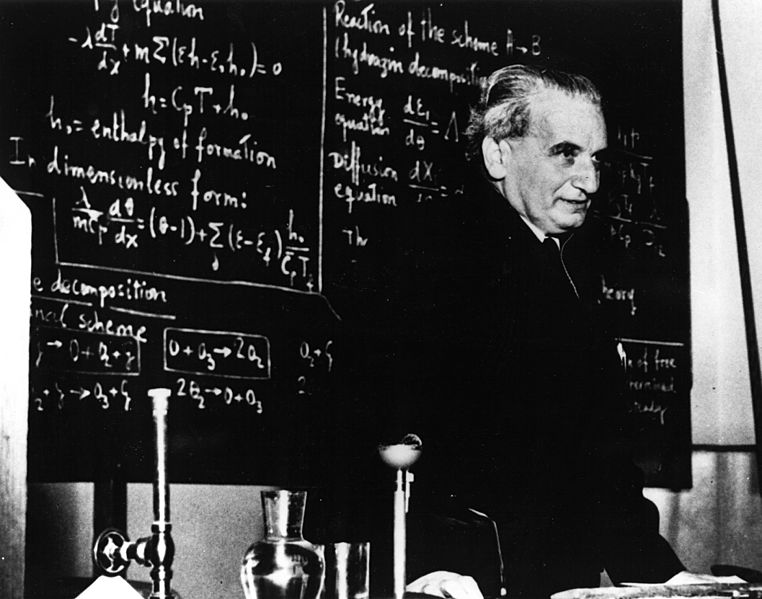Image: Theodore von Karman - GPN-2000-001500

Description: Dr. Theodore von Karman, co-founder of the Jet Propulsion Laboratory (JPL) Pasadena, California was an aeronautical theoretician. His contributions in the fields of aerodynamics and aeronautical engineering are well documented and well known to every aerospace engineer. He was the first winner of the prestigious U.S. Medal of Science presented to him by President John F. Kennedy. As well as being co-founder of JPL, he also was principal founder of a major rocket propulsion firm (Aerojet-General Corp.), the top science advisor to the U.S. Air Force during its transition to jet propulsion aircraft and the top science advisor to NATO. He was, during much of this time, the fountainhead of aerodynamic thought as head of the Guggenheim Aeronautical Laboratory at the California Institute of Technology (GALCIT) in Pasadena, California. In the May 1956 issue of the Journal of Aeronautical Sciences, it was said of him that "No other man has had so great an impact on the development of aeronautical science in this country. Hundreds of young men became his students and scientific collaborators and were inspired to greater effort." Dr. William H. Pickering, then director of JPL said in 1960 "We wouldn't have an aeronautical science as we know it today, if it weren't for Dr. Thoedore von Karman." Under his guidance, Caltech's 10 foot wind tunnel was designed, built and operated. Industry firms such as Douglas, Northrop, Hughes, Lockheed, North American, Vultee and Consolidated all tested new aeronautical designs and concepts in GALCIT's tunnel. Even Boeing's own high-speed wind tunnel was heavily influenced by suggestions from von Karman. The National Advisory Committee for Aeronautics (NACA) became so concerned about GALCIT's growing influence over West coast aviation, it erected the Ames Laboratory in Sunnyvale, California in part to deter an ever widening aeronautical gap that had formed between NACA and GALCIT. From 1936 to 1940, Caltech stood alone as the only university-based rocket research center. Von Karman gambled his prestige by supporting Frank Malina and H.S. Tsien's work on rocketry. Other institutions of higher learning dismissed such research as 'fantastical' and left such endeavors to visionaries like Robert Goddard. Foundational theoretical research by Von Karman gave rise to the first successful solid-fuel rocket engine firings. This led to federal funding for studies that lead to a form of aircraft rocket propulsion called Jet Assisted Take-Off or (JATO). Success in this endeavor led to von Karman establishing two more highly regarded institutions; both originally dedicated to rocketry: the Aerojet Engineering Company and the Jet Propulsion Laboratory. The last years of his life were spent in Paris, his favorite city. His interest in aeronautical research and contributions to it never waned. He organized in Paris the NATO Advisory Group for Aeronautical Research and Development (AGARD). Staffed by American and European scientists eager to serve, its many committees investigated such disciplines as propulsion, aerodynamics and electronics. The legacy of his personable leadership and 'soft touch' approach to problem solving was only equalled by his genius.
Title: Theodore von Karman - GPN-2000-001500
Credit: Great Images in NASA Description
Author: NACA
Permission: This file is in the public domain in the United States because it was solely created by NASA. NASA copyright policy states that "NASA material is not protected by copyright unless noted". (See Template:PD-USGov, NASA copyright policy page or JPL Image Use Policy.) Warnings: Use of NASA logos, insignia and emblems is restricted per U.S. law 14 CFR 1221. The NASA website hosts a large number of images from the Soviet/Russian space agency, and other non-American space agencies. These are not necessarily in the public domain. Materials based on Hubble Space Telescope data may be copyrighted if they are not explicitly produced by the STScI.[1] See also Template:PD-Hubble and Template:Cc-Hubble. The SOHO (ESA & NASA) joint project implies that all materials created by its probe are copyrighted and require permission for commercial non-educational use. [2] Images featured on the Astronomy Picture of the Day (APOD) web site may be copyrighted. [3] The National Space Science Data Center (NSSDC) site has been known to host copyrighted content even though its photo gallery FAQ states that all of the images in the photo gallery are in the public domain.
Usage Terms: Public domain
License: Public domain
Attribution Required?: No
Image usage
The following page links to this image:

